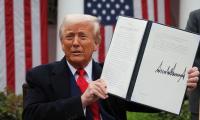It would not be wrong to say that the complexities of modern democratic systems cannot be comprehended without a firm understanding of the role of political parties.
Political parties are multi-faceted and complex organisations that have historically performed a variety of different functions. Over the past few decades, different scholars have tried to understand different dimensions of political parties in the US – such as, party organisations, parties in the government and parties in the electorate. Some experts argue that political parties are quite strong and have been getting stronger, while others believe that the influence of political parties is declining. However, since the early 1960s, the predominant view in academic research is that the influence of parties is declining.
In 1989, Kenneth Shepsle, an American political scientist, coined the term ‘Textbook Congress’ to describe a legislative structure in which committees played a key role and party leaders were nothing more than coordinators. This perspective was primarily based on the conventional wisdom in American politics that congressmen are interested only in getting re-elected and political parties only serve to facilitate them. In other words, congressmen were like independent entrepreneurs who pursue an expansive legislative agenda to ensure electoral security and parties do not have much political relevance in the legislative process.
Whether this view bears empirical scrutiny today remains an open question. While political parties in the US wielded enormous influence in the late 19th century, they are losing their relevance in the face of modern political realities. The decline of political parties is the direct result of the campaign finance laws of the 1970s and the rapid emergence of interest groups representing specialised interests.
Another probable reason is the adoption of direct primaries for the nomination of candidates – which goes a long way to loosen the grip of party elites on the nomination process. After political parties lose control over the nomination process, they also lose the ability to control the way political candidates run their election campaigns. The election of Donald Trump, despite strong opposition from the establishment Republicans, shows how deep the problem goes. President Obama’s victory in the 2008 campaign for the Democratic nomination was a great example of a candidate’s triumph over the (pro-Clinton) party establishment.
Even though political parties are still relevant when it comes to voting in Congress, they have a limited ability to influence electoral outcomes. A candidate who has a lot of money can use the media to make an impression on gullible voters and win elections. Parties have a limited role in the recruitment of political candidates. The rise of unconventional candidates like Donald Trump and Bernie Sanders shows how weak party organisations are unable to deal with high electoral volatility.
The rise of incumbency advantage has made ‘candidate-centered’ politics more common in the US. The interesting development is that the link between party identification and voting continues to grow stronger even when party organisations are getting weaker. What explains this apparent irony? Political parties are weak as administrative organisations but partisanship as an idea is strong among the public.
Political parties are weak because money equals power in US politics, and power has shifted to interest groups and other informal structures. In addition, decentralised party structures and citizen grassroots movements have reduced the influence of political parties in the electorate. This is why congressmen are usually found to be much more worried about their popularity in their respective constituencies than about support from party elites. Since they do not solely rely on parties for funding, political candidates in the US are far more independent of party control than politicians are in parliamentary democracies.
Party leaders are no longer able to rein in the caucuses and impose party discipline. The departure of John Boehner, the former speaker of the House, in 2015 showed how party leaders are coming to terms with powerlessness. They are unable to control the legislative agenda in Congress and have no say in who is nominated. However, the strength of partisanship continues to make sure that supporters of both parties ultimately vote for whoever the party nominee is. Yet, a systematic analysis about the role of political parties is not possible without addressing challenges to establish clear empirical evidence of party influence. We need to have a better conceptual understanding of what constitutes party strength, preference homogeneity and polarisation among parties. How do we measure homogeneity within constituent coalitions?
The defining characteristic of US politics in the present era is that party organisations are weak while partisanship is strong. Parties are losing support in the electorate. The empirical evidence supporting this argument shows a clear lack of support for political parties among young Americans. Independent voters are the fastest-growing section of the electorate. According to a survey conducted by Pew Research Center in 2016, 48 percent of millennials wish to vote without specifying a political party preference. This is almost as many supporters as both the Republicans and Democrats have combined. However, the fact that most independent voters consistently end up voting for one party or another is a sign of strong parties and not of the strength of party organisations.
In a nutshell, the strong relationship between party membership and roll call voting should not make us believe that parties are getting stronger because there is a different between the strength of parties and partisanship.
Strong partisanship in US politics has led to a lack to support for institutions such as Congress and the presidency. Most citizens analyse the performance of these national institutions through a partisan lens. More alarmingly, this partisanship not only shapes political behaviour but also affects a broad range of attitudes about everyday life. And this is the reason why US politics has become so effective.
Email:rizwanasghar5@unm.edu
Invention of Bakelite by Belgian chemist Leo Baekeland in 1907 marked beginning of large-scale plastic production
It was found that at least 60% of answers given by AI were inaccurate or blatantly incorrect
Apple and other manufacturing giants face skyrocketing costs as their China-based supply chains get taxed into oblivion
Pakistani mills buy American cotton, turn it into products, and sell those goods back to American consumers
Senior Pakistani delegation is scheduled to visit Washington for trade and tariff negotiations
Sialkot’s products meet stringent international quality standards, ensuring reliability and safety in medical...







